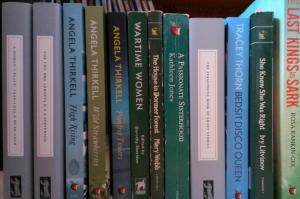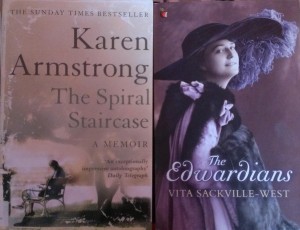 What a treat – my All Virago/All August reading is coming along beautifully: we’re allowed to include Persephones as another strong and marvellous women-centric reprints publisher, and I’ve been wallowing in the Persephones that I’ve been stacking up since Christmas. For those who don’t know them, Persephone Books republish books by mid-20th century women (in the main) writers who have gone out of print and been otherwise neglected. I collect, read and review them, although not to the extent that some others do – and you can find all of my Persephone reviews if you do a little search. Oh, yes, there’s a gorgeous shop in Lambs Conduit Street in London, which you really ought to visit if you’re around that way (OK, in London. OK, in the UK). And the books themselves are lovely – good, solid, well-produced paperbacks in grey dustjackets with glorious endpapers and bookmarks featuring a fabric pattern contemporary to the book.
What a treat – my All Virago/All August reading is coming along beautifully: we’re allowed to include Persephones as another strong and marvellous women-centric reprints publisher, and I’ve been wallowing in the Persephones that I’ve been stacking up since Christmas. For those who don’t know them, Persephone Books republish books by mid-20th century women (in the main) writers who have gone out of print and been otherwise neglected. I collect, read and review them, although not to the extent that some others do – and you can find all of my Persephone reviews if you do a little search. Oh, yes, there’s a gorgeous shop in Lambs Conduit Street in London, which you really ought to visit if you’re around that way (OK, in London. OK, in the UK). And the books themselves are lovely – good, solid, well-produced paperbacks in grey dustjackets with glorious endpapers and bookmarks featuring a fabric pattern contemporary to the book.
Enough going on – here’s what I thought of my latest two Persephone reads, and you can read about my two latest acquisitions below, too (one a Virago!)
Ruth Adam – “A Women’s Place 1910-1975” (Persephone)
(25 December 2013, from Bridget)
An excellent work which looks at women’s conditions and experience in terms of family, relationships, politics, sex and work through much of the 20th century. A thorough and analytical viewpoint meant that I learnt a lot about the suffragettes, the struggle for equal pay in various professions, and women’s entry into those professions, and linkages between various subjects that make logical sense when you consider them, which I hadn’t actually known about or considered before. I do count myself fairly knowledgeable about this period and subject, so that was a nice surprise alongside the recognition of various figures and campaigns that I found throughout the read.
The book is full of meticulously researched detail and quotations from contemporary sources. It was very interesting to read the author’s take on contemporary (early 1970s) reactions to the wave of feminism which was hitting the UK at that time, especially the point about how UK feminism different from its US counterpart with its civil rights affiliation and techniques of consciousness raising, etc.
It’s extremely good on the way that society in general (i.e. The Establishment) has sought to compel women to, variously, go out to work, stay at home, be more masculine, be more feminine, have more or fewer children, in order to suit its own economic and political ends. Related to this are reminders of how much women’s lives changed during this period, so that women in corsets who were expected to keep their children to a strict routine saw their daughters showing their knees and their grand-daughters fixated on spending every moment with their babies so as to avoid psychologically damaging them.
A good afterword written in 2000 make Persephone Book No. 20 an excellent all-round read – very thought-provoking but also written in an accessible, clear style with its learning worn lightly, but underpinning the whole.
D. E. Stevenson – “The Two Mrs Abbotts” (Persephone)
(25 December 2013, from Matthew)
A charming book and a joy to read, gulped down in a couple of days with the delicious prospect hovering of re-reading the whole lot in one go at some point, as this is the second sequel to the marvellous “Miss Buncle’s Book”.
We’re firmly established in village life here, with Barbara and Jerry Abbott and their friends and neighbours enduring the Second World War however they can, with soldiers all over the place, evacuees taking or not taking to country life, and standards of housekeeping being strictly upheld by most, even when it is tricky to get macaroni ready-made or bake a decent cake.
Various romantic threads are woven together successfully and sweetly, but it does not overdo the saccharine, having some tart observations to make about people’s attitudes to one another, the effects of upbringing being explored (prodigy Lancreste becomes a bore, while a wild evacuee might be trainable to overcome her bad start in life) and an excellent new writer character struggling with the processes of creativity and saleability.
Being written in 1943 gives this book a poignancy I have found in other mid-war books; we cannot help but remember that the author did not know what the outcome or progress of the war would be as she was writing. This does give the book a fresh and contemporary feel, as it’s fairly obviously written from some amount of direct experience. Although the war tends not to directly affect the central characters, there is a brave and experimental passage set in North Africa, and some exploration of how to lead men and the nature of officers and men.
A lovely warm bath of a book for all this exploration and interest. There is no afterword, but the reader is directed in a publisher’s note to the afterwords in “Miss Buncle’s Book” and “Miss Buncle Married“, and surely no one who is reading this volume can fail to have read the other two first!
———-
Two lovely Persephones, and two more for the Century of Books, too!
 Two acquisitions to report – the Karen Armstrong was picked up from a pile of books my friend Linda passed to me that were registered on BookCrossing. I’ve had a vague yearning to read this for ages, but never expressed this, so it was interesting that it just came to me in this manner! And Vita Sackville-West’s “The Edwardians” was sent to me by the lovely Kaggsy, who’s been doing a weeding exercise and discovered she had a duplicate. That one’s a Virago, so I’ll try to slot it in this month! Thanks, both!
Two acquisitions to report – the Karen Armstrong was picked up from a pile of books my friend Linda passed to me that were registered on BookCrossing. I’ve had a vague yearning to read this for ages, but never expressed this, so it was interesting that it just came to me in this manner! And Vita Sackville-West’s “The Edwardians” was sent to me by the lovely Kaggsy, who’s been doing a weeding exercise and discovered she had a duplicate. That one’s a Virago, so I’ll try to slot it in this month! Thanks, both!
Currently reading – “The Persephone Book of Short Stories”, and I can’t resist another Angela Thirkell for very much longer …

Aug 17, 2014 @ 19:21:22
I read “A Woman’s Place” in the Virago edition – maybe I should have shelled out for the Persephone as well…… Much as I like old greens I have to say that the modern cover of “The Edwardians” *is* very nice!
LikeLike
Aug 20, 2014 @ 15:17:53
I didn’t know there was a Virago of it. It was excellent, but luckily I don’t need to collect the Virago one too! Yes, that is a lovely cover. I can’t wait to read it!
LikeLike
Aug 17, 2014 @ 19:38:26
How lovely to have two Persephone books to read back to back, a treat indeed.
LikeLike
Aug 20, 2014 @ 15:18:35
AND I started the “Persephone Book of Short Stories” directly after those and got into a terrible frenzy of “just one more story … just one more …” when I did so!
LikeLike
Aug 20, 2014 @ 16:58:13
I loved that collection.
LikeLike
Aug 18, 2014 @ 11:15:08
I’ve still to read the second Miss Buncle – absolutely loved the first one, so why I haven’t advanced yet is a mystery.
LikeLike
Aug 20, 2014 @ 15:18:57
Advance! Advance! You must! Have you got a copy?
LikeLike
Aug 21, 2014 @ 07:06:01
I have now!
LikeLike
Top books of 2014 (plus state of the TBR and 2015 reading plans) | Adventures in reading, writing and working from home
Jan 01, 2015 @ 16:27:33